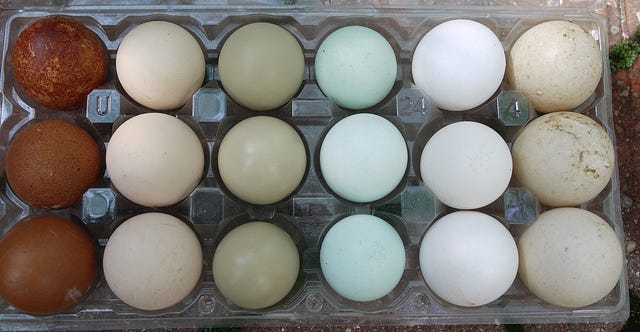
Credit: Rebecca Siegel/Flickr
On a quiet Saturday morning in August, I went on a short jaunt to buy eggs. I feel guilty about my egg consumption, so I usually select the carton with the most generous hen benefit package: my birds should be free to wander and peck, able to flap both wings. (Or so I hope.)
On this August weekend, though, free-range eggs were up to $9 a dozen, which seemed steep even for shoppers like me. A small placard in the refrigerator noted that supply constraints had caused their price to surge. I compromised on a less ethical $6 dozen, trotted home, and immediately googled eggs. That’s when I learned I’d missed the biggest biosecurity story of 2015: avian flu outbreaks had led to the death of 48 million chickens and turkeys.
48 million! What an astonishing number. The questions just tumble from there. Why so many? Why now? What’d they do with all those dead birds? And will we humans soon catch their flu?
Though the last recorded incident of bird flu was in June, a second wave is expected to descend soon, as temperatures drop and wild birds migrate south to their winter dachas, spreading their illnesses along their flyways. So we should worry, we’re told, and perhaps pre-order our Thanksgiving turkeys. But the much more intricate issue is what this year’s flu pandemic portends for the future. According to the USDA, the outbreaks have grown steadily larger since the mid-20th century. And this year has been the worst ever.
In this pop-up publication, A Chicken and Egg Problem, I’m going to explore why the toll of influenza is worsening, how the loss of these birds affects our broader food system, and what we can do to protect our chickens and eggs — and ourselves —from flu outbreaks in the future.
At stake are vital questions about our food security. The U. S. Department of Agriculture has spent more than $600 million so far coping with this pandemic. And it’s not just about the birds — other food producers who rely on eggs, as well as restaurants and corn farmers (who provide feed for our many chickens), are shaken by the losses.
Poultry farms are battening down the hatches to keep out invading viruses, and scientists are developing early detection methods and vaccines. But improving our biosecurity is a staggering challenge. To grasp its scale, I suggest a short course in chicken statistics:
This flu, once colorfully called a “fowl plague,” has hit egg producers the hardest. As of August, with the bulk of our chicken deaths behind us (for now!), we’ve been left with 273 million hens laying omelet-ready eggs, excluding the birds that produce meat.
But why exclude those billions of other chickens? They dodged the flu last spring, but they’re still vulnerable, so let’s invite them in. Because as I started to report the story of our chicken and egg problem, I soon realized: I am a minority in the United States. We are all minorities. Our chickens vastly outnumber us, and maybe we should elect one to Congress.
Every year we produce about 8 billion broiler chickens, the industry term for birds that will soon turn into food. They’re earmarked for death at birth; but really, who isn’t. Most chicken statistics seem to gloss over them, though, focusing instead on the more prestigious class of “layers,” of which we have a total of 360 million, and the birds that grow up to be layers, known as pullets (107 million). Layers lay eggs, some of which are fertile and hatch, and some of which turn into soufflés and scrambles.
The way the industry accounts for its layers is roughly how I imagine future humans will be vat-bred and tracked in spreadsheets. With countless charts and columns devoted to the “Number of Layers on Hand” each month and the “Number of Hatching Type Layers on Hand,” and “Number of All Pullets on Hand First Day of Month,” all organized neatly by type and flock size, it becomes clear that the USDA views these birds as a strategic resource. They fall somewhere between combat-ready platoon and national treasure. Too valuable to be left in the hands of fate, these birds are counted and tracked and shaped for efficiency. Like Olympic runners shaving off seconds, they are nudged to produce eggs as fast as they can. And in classic dystopian fashion, some charts hint at a clenched fist inside its velvet glove: “Percent of All Layers being Force Molted First Day of the Month” and “Number Slaughtered, Lost, and Added During the Month.”
So it’s no wonder that the sudden thinning of their ranks should provoke panic. The timely annihilation of infected flocks has curbed the flu’s spread, but that’s not a strategy we could use if the virus were to jump to humans — a very real, but for now speculative, threat. And I haven’t even gotten to the turkeys. The culled turkeys, of course, were all future meat. In addressing the turkey losses, this Bloomberg story had the money quote:
“After all this death, all these meat birds never came to slaughter,” said Russ Whitman, vice president at Urner Barry in Bayville, New Jersey.
In my next post I’ll look at ways the poultry industry is adapting to protect its birds from dying off-schedule.